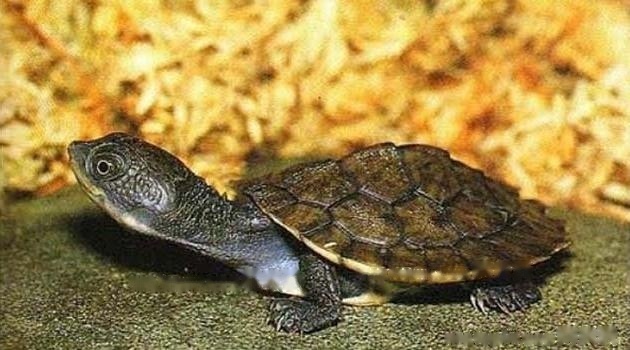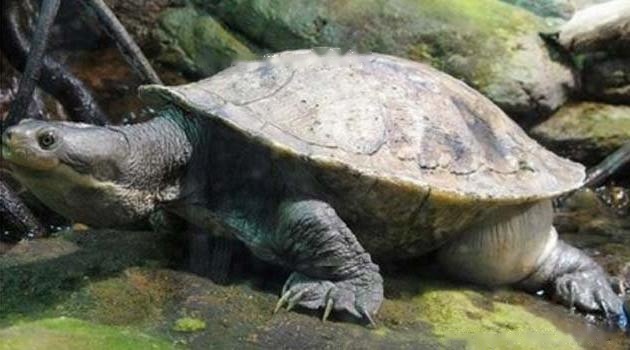The New Guinea armored tortoise, distributed in the eastern half of New Guinea and the nearby Bismarck Islands, Bougainville and other areas. The New Guinea armored turtle is active from April to October. The New Guinea armored tortoise is currently bred in many parts of Europe and the United States. It is strongly recommended that lovers do not buy wild turtles. Compared to hardy, hardy captive-bred products, capture, management, and storage and transportation with other species will place a great deal of pressure on wild Aboriginal tortoises, which are often makes them very weak.

The New Guinea armor turtle carapace is olive to dark brown, unpatterned, smooth and ribbed. There is no very hypertrophic edge shield. The plastron is yellow to brown, with two hinge joints and 11 scutellum. Male turtles have well-developed spikes at the end of their tails and rough scales on the inside of their hind legs. Male turtles are obviously smaller than female turtles. Like most aquatic turtles, male turtles have the characteristics of inking. Male turtles have very thick tails, and adults are mostly 9~10CM. Female turtles are large and wide, and adults are mostly 11~10 cm. 13cm. Male turtles have a piece of hard keratinized skin on the crook of their hind legs, which is used to hold the female turtle during mating. Since the tails of males and females are very different, you don't need to look at anything else, just look at the tails.
New Guinea armored turtle, including the eastern half of New Guinea Island and nearby Bismarck Islands, Bougainville Island and other regions. Habitat, mainly fresh or brackish water. The New Guinea armored turtle prefers shallow waters with soft bottoms, slow flow, and lush vegetation. And often occupy the muskrat's residence.
The New Guinea Tortoise is active from April to October. During the warmer months, they can be seen wandering around the bottom of the water foraging. If the habitat dries up, the tortoises move over land into a permanent body of water, or bury in the dirt and go into aestivation. They are surprisingly terrestrial and can often be seen crossing roads, killing many turtles.

environment The raw materials need a foam box, a heating rod, a heating box with a lid (large plastic box), and several hatching boxes with a lid. The specific heat of water is large again, the temperature change is small for heating, and the incubation box is used for moisturizing. First, open the heating box (large plastic box) with a cover, and iron a circular slot on the box, which can be inserted into the wire of the heating rod. Adjust the heating rod to 30 degrees, add warm water, and cover the box. In this way, the heating part is done. Since the large plastic box is basically sealed, the water vapor will not evaporate, and it is easier to control the humidity than the steamed bun heating method. Then put the heating box on the bottom of the foam box, put the incubation box on top, use the incubation box to punch holes and spray water to control the humidity, cover the foam box, and iron a circular slot on the upper edge of the foam box, which can be inserted into the heating rod. In this way, a basically sealed incubator is ready, and the temperature is very stable. Because the heating box is basically sealed, there is no need to change the water for a long time, and there is no need to worry about the problem of high humidity in the later stage of the turtle eggs.
Feeding The larvae of the New Guinea armored turtle will quickly consume the food provided. To avoid overfeeding, feeding every 1 to 2 days is recommended. Tortoise seedlings have a very mixed diet, eating insects and thawed frozen suckling mice, as well as some green leafy vegetables. Note that they like to bite the tip of their cannibal's tail. Any aquatic plant such as waterweed is their favorite food. With age, the proportion of plants in the food will gradually increase. Many commercially available turtle foods are ideal for juvenile Australopithecus turtles. Calcium supplementation is essential for maintaining the health of the northern turtle. Calcium powder can be sprinkled on all foods. It is recommended to use calcium and vitamin D3 supplements for the Australis tortoises raised indoors, and calcium supplements for Australis tortoises raised outdoors, while providing fish bones for chewing.
Breeding The male turtle is obviously smaller than the female turtle, and the male turtle, like most water turtles, has the characteristics of inking, Male tortoises have very thick tails, adults are mostly 9-10CM, female turtles are large and wide, and adults are mostly 11-13CM. Male turtles have a piece of hard keratinized skin on the crook of their hind legs, which is used to hold the female turtle during mating. Since the tails of males and females are very different, you don't need to look at anything else, just look at the tails. There is no difference between hatching and hatching of general aquatic turtles. Generally, it is artificial hatching at a constant temperature of 30 degrees, and the humidity is controlled at more than 95% in the early stage. After a large number of bloodshots appear in one and a half months, the humidity can be slightly lower, and the eggs are exposed slightly more. After two and a half months, the humidity of about 80% is enough, and then the eggs are exposed more, and a small half of the eggs are in the vermiculite. Generally speaking, it takes about 85 days to 95 days.
![[Dog Training 5] The training method of pet dog dining etiquette](/static/img/12192/12192_1.jpg)





